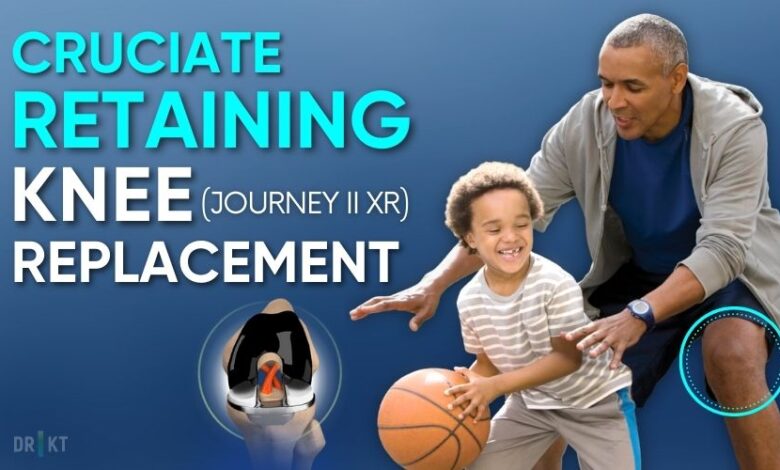
Maintaining healthy joints is crucial for leading an active life. However, aging, certain medical conditions, or injuries can cause various joint issues. The knee joints are particularly prone to these problems.
If these knee issues are not treated timely, osteoarthritis of the knee can develop which is a condition commonly referred to as “wear and tear” arthritis. Knee osteoarthritis can naturally occur in older age. Additionally, it can develop at a younger age due to sports injuries, accidents, or diseases. Knee osteoarthritis can lead to chronic pain, swelling and stiffening of the knee joint and restricted mobility.
Today, there are numerous treatment options available for knee osteoarthritis. In the early stages of osteoarthritis, treatment may involve several non- surgical techniques. However, in cases of severe and advanced osteoarthritis, knee replacement surgery may be necessary. Knee replacement surgeries are performed to provide a permanent and definitive solution to relieve pain and restore knee function.
To achieve optimal outcomes and enhance patient satisfaction, various innovations have been developed over time. Today, patients have several options: Technology (traditional/robotic surgery) in knee replacement surgeries, the selection of surgical technique (mechanical/kinematic), and the type of knee replacement implants are all extremely important.
The most suitable option is the one that best meets the patient’s specific needs. For instance, for patients who lead an active lifestyle and athletes, the Journey II XR knee implant might be the best knee replacement implants. Advances in biomedical engineering software are enabling the creation of superior knee implants with enhanced performance. The Journey II XR knee implant has revolutionized knee prosthesis design with its resemblance to the natural joint structure and its protective features for the anterior and posterior cruciate ligaments.
Journey II XR knee implant, which is among the best knee replacement implant brands today, has now started to be used in knee replacement surgeries in Türkiye.
If you would like to learn more about all the features of the Journey II XR knee implants, which protects the cruciate ligaments of the knee, and the advantages it offers to patients, you can find out more by reading the rest of our article.
Contents:
- How is Knee Replacement Surgery Performed? What are the Options?
- Best Knee Replacement Brand: Journey II XR Knee Replacement Protecting the Cruciate Ligaments
- Journey II XR Features
- Journey II XR Advantages
- Limitations of Journey II XR
- Who Can Journey II XR Be Applied To?
- To whom is Journey II XR not applicable?
- Operation Process
- Conclusion
How is Knee Replacement Surgery Performed? What are the options?
Knee replacement surgery, also known as knee arthroplasty, is a surgical procedure designed to restore functionality to knee joints compromised by osteoarthritis, degenerative conditions, or injury. This intervention aims to alleviate chronic knee pain associated with knee osteoarthritis and significantly enhance joint mobility.
The anticipated outcomes of knee replacement surgery can vary significantly among individuals. While some patients primarily seek relief from persistent pain and a return to basic daily activities, others aspire to regain a more dynamic lifestyle. This may include resuming professional duties, engaging in sports, participating in recreational activities such as dancing, or pursuing hobbies like gardening. Given this spectrum of expectations, it is crucial that healthcare providers thoroughly discuss available options with each patient, tailoring the surgical approach to align with individual needs and lifestyle requirements.
Key Considerations for Knee Replacement Surgery
When contemplating knee replacement surgery, three essential factors must be carefully evaluated:
1- Techniques for Implant Alignment
For many years, doctors aimed to make knee replacements (TKA) as straight as possible to make them last longer and work well. This method, called Mechanical Alignment (MA). The aim of Mechanical Alignment (MA) technique for TKA is not to restore the constitutional patient-specific alignment but rather to systematically create a “biomechanically friendly prosthetic knee”. Although it has helped implants last, but many patients still had pain and weren’t fully happy with the results.
Recently, doctors have been trying a new approach called Kinematic Alignment (KA) with the hope they would improve knee kinematics and functional outcomes of TKA. This method tries to copy the natural shape and movement of the patient’s own knee before it was damaged. The goal is to reduce pain and improve how the knee works after the replacement. Kinematic Alignment is a newer technique that uses different measurements to position the new knee (implant) parts.
2- Surgical Technologies
Knee replacement surgeries can be performed with traditional hand instruments or robotic surgery. Surgeons have been using traditional hand instruments since the 1970s to insert the new knee implants. Unfortunately, these hand tools have sensitivity limits. So surgeons have a hard time getting the measurements they want.
Robotic knee replacement surgery is a modern technology that enables the appropriate and accurate surgical procedure to be performed with 3-dimensional digital planning. The risk of technical errors is minimized in knee replacement surgeries performed under robotic surgical guidance. Thus, the surgical procedure can be performed with high precision and pinpoint accuracy.
3- Types of Knee Prosthesis
The knee replacement implant is very diverse in design and material. Therefore, many criteria should be considered when choosing knee implants. These criteria are: the design of the implants, its functions, the materials used and its compatibility with the knee. For example, some of the metal materials used in knee replacements can enter the bloodstream as they wear and cause allergies. It is important to choose the most suitable knee replacement implants to avoid such incompatibilities.
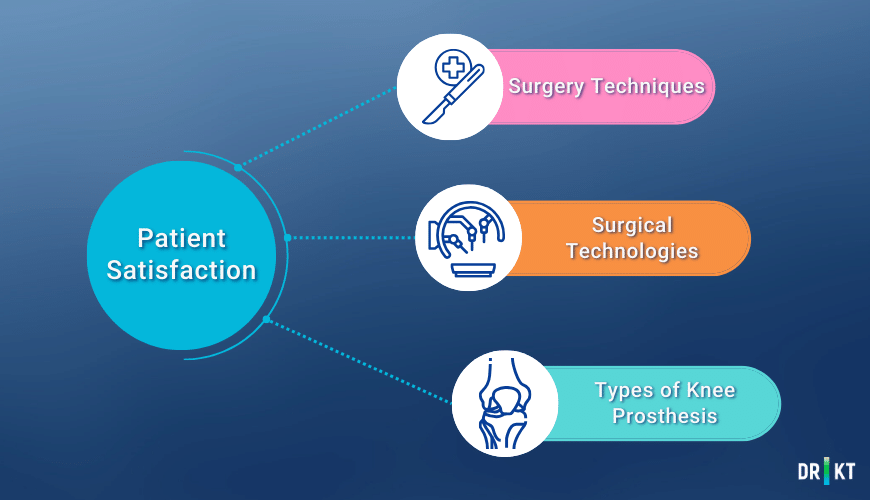
All these factors are considered to influence patients’ satisfaction with the outcome after knee replacement surgery. For this reason, research and developments are being carried out to increase patient satisfaction. For example, recent developments in knee replacement design can be considered as a revolutionary solution and innovation in knee replacement surgeries.
Best Knee Replacement Implant Brand: Journey II XR Knee Implants Protecting Cruciate Ligaments
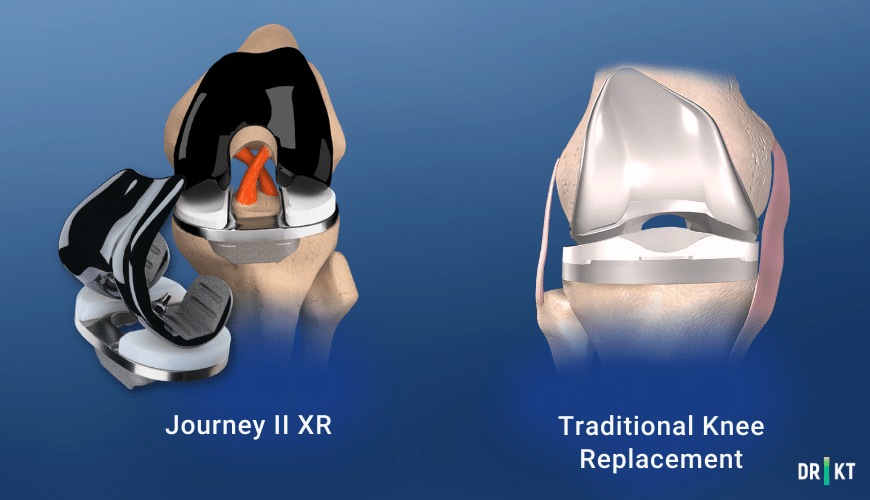
The role of the anterior and posterior cruciate ligaments in normal knee anatomy is to prevent the knee from becoming lax, to provide joint stability and to promote safety of movement.
However, in traditional knee replacement surgeries, one or both of the anterior and posterior cruciate ligaments in the knee must be cut to place the implant in the knee. For this reason, after surgery, some patients may complain of not experiencing a natural and strong knee sensation when moving.
Recently, the Journey II XR knee replacement ımplant has been developed to address these problems, especially for those who want to return to an active and sporting lifestyle.
The Journey II XR knee implants opens the door to a new era in knee replacement surgery by protecting the anterior and posterior cruciate ligaments in the normal structure of the knee.
The knee replacement surgery performed with Journey II XR is defined as “Bi-Cruciate Retaining Knee Arthroplasty”. This revolutionary knee implanta aims to increase the post-operative satisfaction of patients with knee arthritis, accelerate the healing process and offer a more active life.
Designed especially for people who lead active lives and athletes, the Journey II XR may be as the best knee replacement implant for athletes by allowing the ACL to be retained. An anatomical design is intended to help a smoother recovery, improved function and higher patient satisfaction.
With the Journey II XR knee replacement, it is possible to perform at a higher level and lead a more active life with the protection of the cruciate ligaments. Therefore, the Journey II XR knee replacement is the best knee replacement implant brand.
Features of the Journey II XR Knee Replacement Implants
One of the most important factors affecting the success of knee replacement surgery is the type of implants to be used. Every knee replacement design faces two major challenges. The first is to recreate the normal swing-and-rotate motion of natural knee. The second is to restore stability to knee joint after surgery.
To overcome these challenges, knee implant designs are constantly being developed and improved. The innovative JOURNEY II XR knee replacement implant is different from most other knee implants. Its aim is to help patients restore normal knee function, move without pain and lead a more active life.
The features of the Journey II XR knee implant that protects the knee ligaments are as follows.
- Similarity to Natural Knee Anatomy: The Journey II XR knee replacement features an anatomically shaped femoral component that mimics the natural angles of the human leg. In this way, it can help the knee to return to its natural movements after surgery, without the need for the muscles and other soft tissues surrounding the knee to adapt to unfamiliar stresses.
- Design to Protect the Cruciate Ligaments: The JOURNEY II XR knee replacement uses a U-shaped tibial base plate that fits around the healthy anterior cruciate ligament (ACL) and posterior cruciate ligament (PCL). This preserves the ACL and PCL during surgery. Knee joint stability is ensured and normal function is resumed.
- Material Used: The Journey II XR knee replacement is more durable because it is made using two special materials (OXINIUM metal alloy and high cross-linked plastic). OXINIUM metal alloy is twice as hard as cobalt chrome, the most commonly used metal in knee implants, implants made with OXINIUM material have been shown in lab testing to reduce joint wear by more than 80% when compared to cobalt chromium components. Another feature of the OXINIUM metal alloy is that it is free of risks such as metal allergies. Therefore, it is the most suitable and best knee replacement brand for patients with metal allergies and sensitivity.

Advantages of Bi-Cruciate Retaining Knee Replacement (Journey II XR)
The goal of prosthetic surgeries is to help patients regain normal knee function, allowing them to move without pain. The Journey II XR knee replacement, which protects the knee ligaments, offers many additional advantages thanks to its special design.
- Wide Range of Motion: The normal knee designs of JOURNEY II TKA have shown to deliver improvements in both knee function and motion. Patients can easily return to their daily lives and lead an active life.
- Faster Recovery: Faster recovery is seen after surgery compared to traditional knee replacement surgeries. Muscles are in a stronger state. This makes it easier to move.
- High Patient Satisfaction: Quicker recovery, improved function and normal kinematic patterns of motion lead to high levels of patient satisfaction.
- Better Stability: By retaining ACL and including JOURNEY’s anatomic shapes, the system is designed to improve stability throughout the range of motion. This means a more stable posture, good balance, comfortable walking and a high degree of safety for other physical activities.
- Long Lasting and Durable: The JOURNEY II XR implant addresses durability with a combination of two wear reducing materials – the proprietary OXINIUM metal alloy and a highly cross-linked plastic insert – that were designed to address wear on both surfaces of the implant. implants made with OXINIUM material have been shown in lab testing to reduce joint wear by more than 80% when compared to cobalt chromium components. This reduces the risk of revision surgery in the future.
- More Natural Movement: the JOURNEY II XR uses a U-shaped tibial base plate that fits around your healthy ACL and PCL, allowing them to remain in place and function normally after surgery. In short, the function of these important ligaments doesn’t have to be re-engineered because they were never removed. The implant provides a more natural movement in the knee, allowing patients to perform their daily activities and even some sports more comfortably.
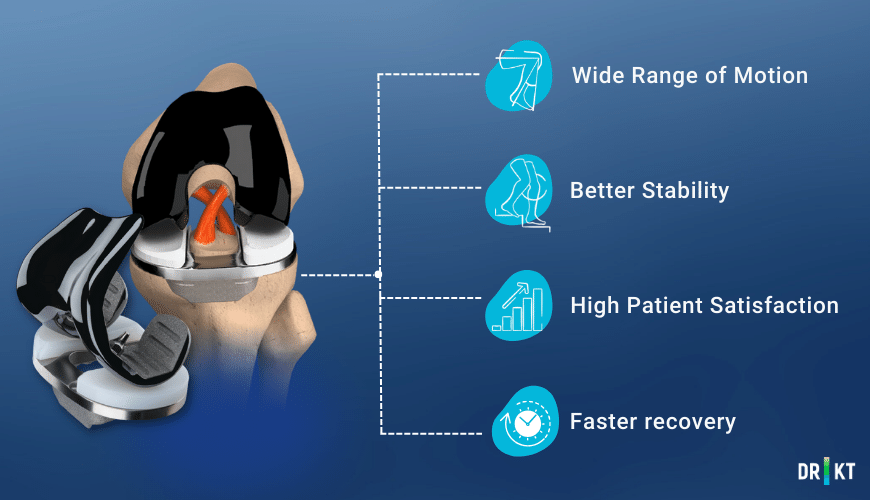
Limitations of the Ligament Preserving Knee Replacement (Journey II XR)
Although the Journey II XR knee replacement has many advantages, it also has some limitations;
- Surgical Challenges: The Journey II XR knee replacement is performed with a more complex surgical technique compared to other procedures. Therefore, orthopedic surgeons who will apply the implant must undergo special training. Therefore, there are few centers and surgeons who can perform knee surgery with the Journey II XR, which protects the knee ligaments. So this service may not be available in every orthopedic clinic.
- Not Suitable for Everyone: The ligament-sparing Journey II XR knee replacement may not be a suitable option for every patient. In some cases, or for patients with certain health conditions, other methods may be required. It is important to consult with a qualified orthopedic surgeon to get the necessary information about the potential benefits and limitations of the Journey II XR knee replacement implant.
Who Can Receive the Journey II XR Ligament Preserving Knee Replacement?
The Journey II XR, a knee implant that protects the anterior and posterior cruciate ligaments (ACL/PCL), may be a implant that many patients may want to choose. However, it is important to have certain health conditions to undergo surgery with this method. Otherwise it may be difficult to achieve the desired result. Journey II XR knee replacement is applicable in the following cases
- Patients with Advanced Osteoarthritis of the Knee: Osteoarthritis is a condition characterized by the wear of joint cartilage. This causes pain in the knee, stiffness and difficulty in movement. A ligament-sparing knee replacement helps to reduce pain and improve mobility in patients who have failed non-operative treatments. However, the Bi-Cruciate Retaining Journey II XR knee replacement can only be used in patients with intact healthy anterior and posterior cruciate ligaments.
- Patients Seeking More Natural Knee Movement: The Journey II XR knee replacement protects both the anterior and posterior cruciate ligaments, allowing for natural, balanced and safe knee movement. This is particularly important for patients who want to return to higher activity levels.
Who Cannot Have a Knee Replacement Journey II XR that Protects the Cruciate Ligaments?
On the other hand, the Journey II XR knee replacement, which protects the anterior and posterior cruciate ligaments, is not used in some cases. These situations are listed below:
- Patients with Severe Cruciate Ligament Injury: The aim of the Bi-Cruciate Retaining Journey II XR knee replacement is to place the implant in the knee without cutting the anterior and posterior cruciate ligaments in the knee joint. It is therefore not a suitable choice for patients with severely damaged or ruptured cruciate ligaments.
- Patients with inflammatory joint diseases such as rheumatoid arthritis: These diseases usually affect the entire joint. It can weaken the integrity of the cruciate ligaments in the knee. This reduces the chance of a Bi-Cruciate Retaining Journey II XR knee replacement surgery.
- Patients with Significant Angular Deformity of the Knee: The Journey II XR implant is not applicable if the patient’s legs have developed significant deformities such as “braces leg” or “X leg” deformities. However, your orthopedic surgeon may recommend a Journey II XR knee replacement, depending on the overall condition of the knee.
- Patients with severe limitation of knee movement: Patients with knee arthritis usually experience pain and difficulty in movement. If the patient has difficulty bending and extending the knee, but can bend and extend it almost completely with someone’s help, there is no permanent limitation. In this case, knee replacement surgery that preserves the knee ligaments can be performed. However, if the doctor finds a limitation of more than 5-10 degrees in passive bending and straight extension of the knee during the examination, a permanent limitation has developed. In this case, the Bi-Cruciate Retaining Journey II XR knee replacement is not recommended.
- Patients with previous knee replacement surgery: In these people, the anterior and posterior cruciate ligaments have already been cut. Therefore, when knee replacement revision surgery is required, there is no chance of a Journey II XR knee replacement.
If you are considering knee replacement surgery, you should discuss your personal health situation and the potential benefits and risks of the Bi-Cruciate Retaining Journey II XR knee replacement with your orthopedic surgeon. After discussing this information, you and your orthopedic surgeon can decide on the best treatment option for you.

The Surgical Process of the Journey II XR Knee Replacement that Protects the Cruciate Ligaments
The Journey II XR knee implant, which protects the ligaments in the treatment of knee arthritis, is as follows:
- Preoperative: Like all other surgical procedures, preoperative evaluation and preparation is performed. Patients’ general health status, activity levels in their daily lives and expectations from treatment are taken into account.
- Surgical Procedure: The surgery is usually performed under general anesthesia or spinal anesthesia and takes several hours. To insert the prosthesis in the knee, the orthopedic surgeon does not cut the anterior and posterior cruciate ligaments in the knee, but preserves them. The damaged joint is replaced with a Bi-Cruciate Retaining Journey II XR knee replacement.
- After Knee Surgery: After surgery, patients are usually recommended a physical therapy and rehabilitation program. This allows the new knee to be moved correctly and patients to recover as quickly as possible.
- Conclusions: It was reported that most patients felt less pain and moved more easily after surgery. The Journey II XR knee replacement usually allows for a faster healing process. Patients can thus return to their active lives more quickly. However, it should be remembered that each patient’s situation is different and the healing process may vary from person to person.
- Risks and Complications: As with all surgical procedures, there are some risks associated with surgery with the Journey II XR knee replacement. Although the likelihood of complications is low, patients should be aware of these risks and get detailed information from their orthopedic doctor. Possible complications after surgery include infection, bleeding, stiffness, pain, nerve damage, wear or loosening of the prosthesis.
Conclusion
The Journey II XR, a cruciate ligament-sparing knee replacement, is a progressive approach to knee arthroplasty surgery that aims to give patients a more natural and active knee feel.
The Bi-Cruciate Retaining Journey II XR knee replacement provides patients with a more natural and comfortable feeling of movement thanks to its similarity to normal knee structure and movement physiology. One of the biggest advantages is that both the anterior cruciate ligament and the posterior cruciate ligament are preserved. They are an important choice, especially for people with active lifestyles, athletes or who want to engage in physical activity.
However, this technique may not be suitable for everyone. Patients with osteoarthritis of the knee should seek the opinion of their orthopedic surgeon and consider the benefits and risks of the Journey II XR knee replacement when assessing whether they are a suitable candidate for the Journey II XR.
If you want to get more information about this knee replacement, you can contact us and ask what you are curious about.

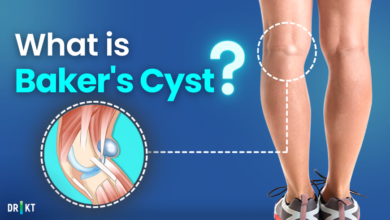
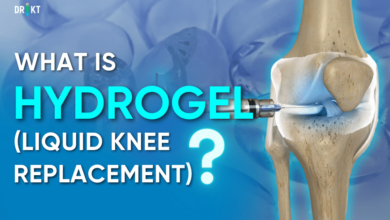

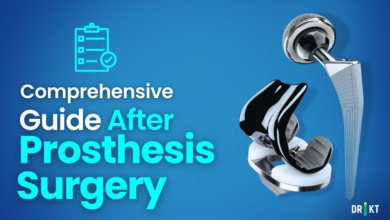
Looking for a surgeon in Buffalo, NY that uses this knee replacement technology.
Thank you for your comment and your question. If you’re looking for a surgeon in Buffalo, NY who uses advanced knee replacement technology, in Turkey, Op. Dr. Kayhan Turan is an experienced orthopedic surgeon who specializes in the latest knee replacement techniques and robotic surgery. He offers the best treatment options tailored to your needs. If you’d like more information or would like to schedule a consultation, feel free to contact us via our free WhatsApp service at +90 505 999 17 77. We are happy to assist you with any questions you may have.
Please refer me to a doctor using this one replacement technology. I live near San Francisco
Hello, first of all, I wish you a speedy recovery. We are based in Bursa, Turkey, and would be happy to assist you with this treatment.If you’d like more information or would like to schedule a consultation, feel free to contact us via our free WhatsApp service at +90 505 999 17 77. We are happy to assist you with any questions you may have.
Need a doctor in Fredericksburg, VA, Richmond, VA, Maryland, or DC. How do I search for the Doctor that uses this type of replacement
Hello, first of all, I wish you a speedy recovery. We are based in Bursa, Turkey, and would be happy to help you with your treatment. If you are interested in exploring this further or would like to schedule a consultation, please don’t hesitate to contact us via our free WhatsApp service at +90 505 999 17 77. We are here to provide all the information you need and assist you with any questions you may have. Our team is dedicated to ensuring you receive the best possible care
Looking for a doctor near Toledo Ohio that uses the Journey II XR,and is qualified
Hello,
First of all, we wish you a speedy recovery.
We can assist you regarding the Journey II XR knee prosthesis. We provide orthopedic and traumatology services at Bursa Private Aritmi Osmangazi Hospital in Turkey.
For detailed information about the treatment process, prosthesis options, or any questions you may have, please feel free to contact us anytime at +90 505 999 17 77.
Wishing you good health!
need have this done in nw missouri any there or near
Hello,Thank you for your comment and your question. We are not fully informed about whether this procedure is available in Northwest Missouri, but we would be happy to assist you. We provide services at Bursa Private Aritmi Osmangazi Hospital in Turkey.
For more information and consultation about the Journey II XR treatment, feel free to contact us anytime at +90 505 999 1 777 .
Please email me the cost for this procedure in Turkey. Thank you.
Hello, first of all, get well soon. We would like to assist you. For a detailed consultation and to provide you with pricing information, you can contact us at +90 505 999 1 777.
Stay healthy.